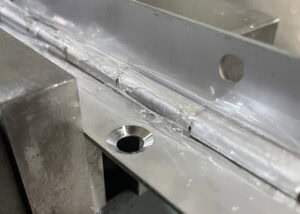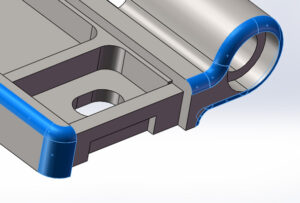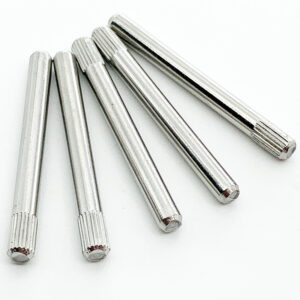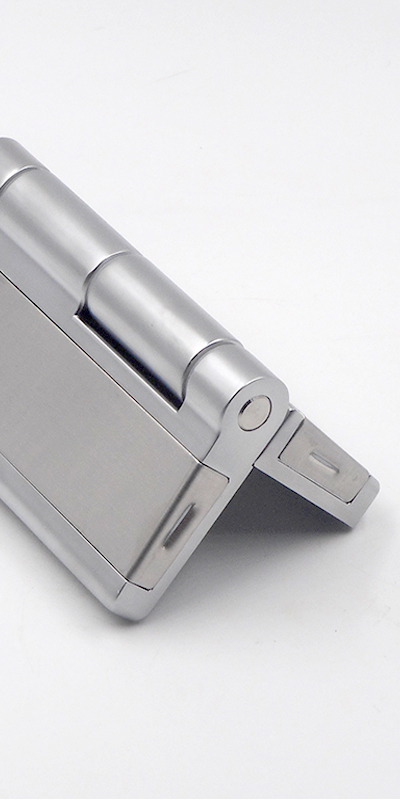Black dust on industrial door hinges signals friction or poor lubrication—both threats to long-term hinge performance.
Black dust on industrial door hinges is typically caused by material wear or evaporated lubricant residue. These residues, often misidentified as mold, originate from internal friction, cheap hinge materials, or substandard lubricants in high-use environments.
Understand the root cause, and you can avoid costly maintenance and system downtime.
Black Dust Is a Result of Friction and Wear
Black dust from hinges is most commonly due to mechanical friction, especially in applications where hinges move frequently. When a hinge’s leaf and pin rub together, it can cause minute particles of the metal to shear off. Over time, this metal dust builds up, appearing as black grime around hinge joints.
In industries like climatic test chambers or cold storage room hinges, hinges endure continuous stress from opening and closing, leading to faster surface degradation. While friction is unavoidable, its severity can be mitigated with correct hinge design and precise manufacturing.
Black dust forms from the mechanical wear between hinge components under repeated motion, particularly in industrial settings where articulation is frequent and forceful.
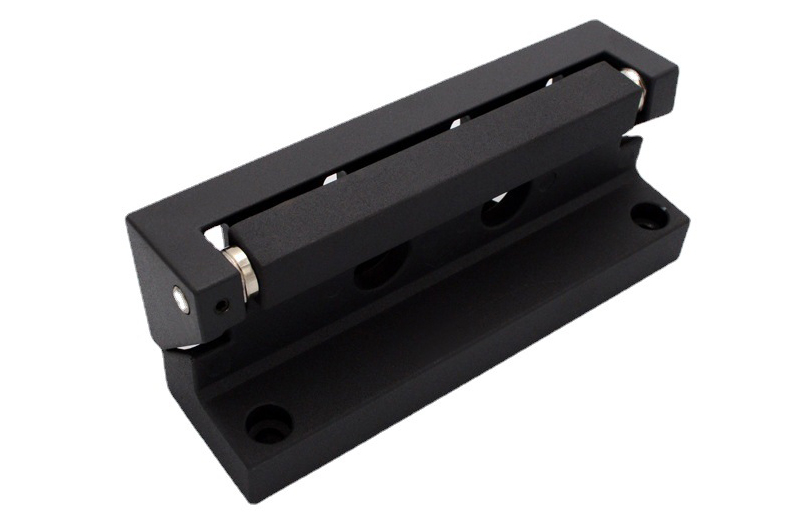
How Hinge Friction Leads to Material Breakdown
Friction causes microabrasions in the hinge metal. As doors open and close, these microabrasions deepen, releasing blackened metallic particles. The situation worsens in poorly lubricated or overloaded hinges.
Industrial applications such as heavy machine enclosures, testing equipment, or trailer compartments use heavy duty hinges or weld on hinges, which are often exposed to more intense stress. If hinge materials are substandard or tolerances too loose, the wear rate increases. Over time, the accumulated dust may compromise not just appearance but also performance.
Low-Quality Hinge Materials Contribute to Dust Accumulation
Material selection in industrial hinge manufacturing is crucial. Hinges made from inferior metals—such as low-grade iron or uncoated alloys—are more prone to deterioration. Such materials lack surface resilience and often cannot handle repetitive articulation or high-pressure loads.
Low-end manufacturing methods may skip treatments like powder coating or nitriding, which protect against wear. These untreated surfaces are a major reason black dust appears sooner in cheaper hinges.
Industrial hinges made from inferior or untreated materials deteriorate faster under load, leading to more visible black residue from wear.
Why Premium Materials Are Necessary in Industrial Settings
High-performance sectors (e.g., medical testing equipment or sheet metal enclosures) demand hinges that endure heavy cycles. Special hinges designed with stainless steel or brass resist dusting longer due to their hardness and anti-corrosion properties.
Factories should source hinges from a reputable industrial hinge production base to guarantee quality. At IHINGES, our hinges undergo rigorous QC and are crafted with materials selected specifically for load durability and longevity.
| Hinge Material | Durability Level | Dust Formation Likelihood |
|---|---|---|
| Low-Grade Steel | Low | High |
| Brass or Stainless | High | Low |
| Coated Carbon Steel | Medium | Medium |
Cheap or Inappropriate Lubricants Evaporate Quickly
Lubricants reduce friction, but when low-grade oils are used, they break down fast—especially in high-heat or high-friction environments. When lubricant dries out or oxidizes, it can leave behind a carbon-like residue that mimics black dust.
Industrial-grade hinges—such as those used in climate chambers or piano hinges for electrical cabinets—require lubricants engineered for endurance under motion, temperature variation, and vibration.
Inappropriate or cheap lubricants degrade quickly, leaving behind blackened residues that resemble mechanical dust on hinge joints.
How to Choose and Apply the Right Lubricant
Use synthetic greases or high-viscosity industrial lubricants designed for metal-on-metal articulation. These formulas maintain lubrication even under stress, avoiding dry runs that generate dust.
Lubrication should also be reapplied as part of routine maintenance, especially in facilities with 24/7 operations. Regular checks prevent hinge seizing and dust buildup. Lubricants with molybdenum disulfide or PTFE are particularly effective for industrial applications.
Poor Surface Finishing Increases Dust Risk
Surface treatment affects how much friction occurs during each hinge cycle. Rough, untreated hinges wear faster and produce more particulate matter. Industrial hinges without polished or chemically treated finishes are more likely to shed material under load.
Common finishes like black oxide or phosphating are cost-effective methods to minimize surface degradation. These coatings reduce the rate at which hinges release particles and offer basic corrosion protection.
Lack of surface finishing on industrial hinges increases friction, accelerating material shedding that results in black dust.
Surface Finishing Techniques for Industrial Hinges
Manufacturers should adopt finishing processes such as:
-
Electroplating: Adds a corrosion-resistant surface layer.
-
Powder Coating: Offers protection and color uniformity.
-
Passivation: Enhances the natural corrosion resistance of stainless steel.
These methods add significant durability without impacting hinge function. Hinges installed in harsh environments—like marine-grade boxes or refrigerated units—benefit immensely from these finishes.
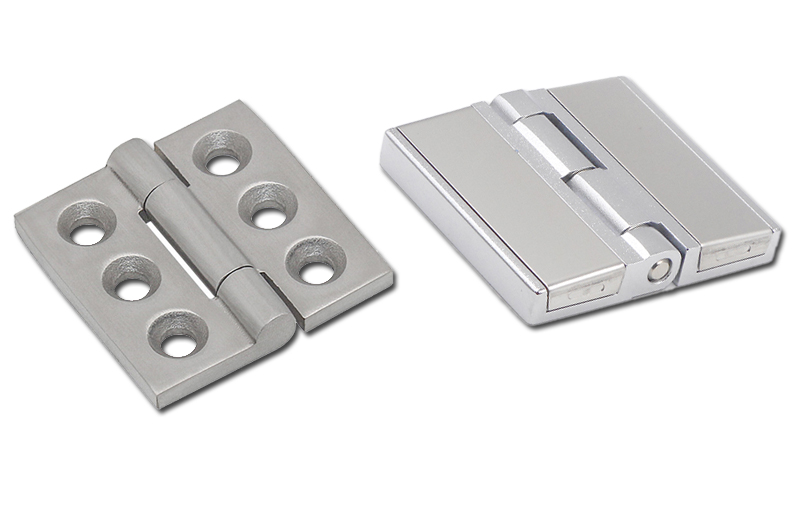
Industrial Heat or Vibration Accelerates Wear
Machines that generate vibrations or high temperatures place unusual stress on hinges. This is especially common in transport equipment or high-speed automation doors. Hinges subjected to thermal expansion and mechanical jolts degrade rapidly, leading to black powder discharge.
Excessive vibration or heat in industrial environments intensifies hinge wear, contributing to black dust buildup over time.
Environments to Watch Out For
Hinges used in mobile equipment like trailer door hinges or in ovens, kilns, and climate-controlled units should be reinforced. They must include heat-tolerant alloys and flexible bearings to prevent premature wear.
Vibration-isolating mounts or brackets can reduce stress transferred to hinges. Also, thermally stable lubricants should be prioritized over petroleum-based products in these contexts.
Conclusion
Black dust on industrial door hinges often signals friction wear or lubricant breakdown. Use high-quality materials, correct surface finishing, and reliable lubricants to extend hinge life and maintain industrial performance.

